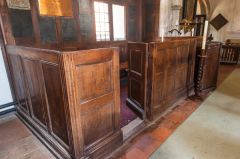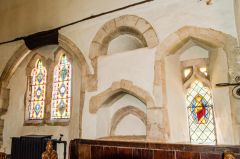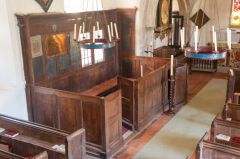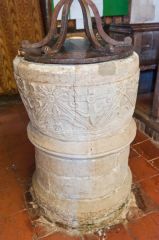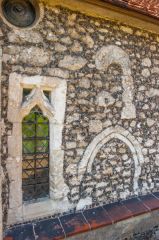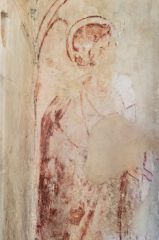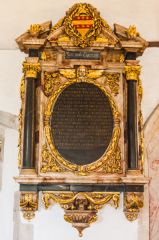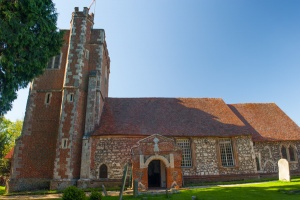
There has been a church here on level ground north of the Thames since the 12th century. The chancel is from that first 12th-century church, but the nave has since been rebuilt, and the floor level raised, perhaps to deal with flooding. The name Dorney means 'Island of the bumble bee', an indication that the area was frequently surrounded by water!
At the west end of the nave is a Norman tub font with nicely carved decorative designs around the bowl. The carving has been described as fleur-de-lys, and also as doves. To my eye, they look like the former!
The font is set at a lower level than the rest of the nave, down several steps. Perhaps it was too difficult to raise the heavy font when the nave floor was raised so it was simply left at the original floor level?
The font stands beneath a wooden 17th-century gallery, which would have been used by musicians playing during services, or perhaps by servants from the manor house who would have been separated from their 'betters' below. The original coat hooks are still set on the gallery walls.
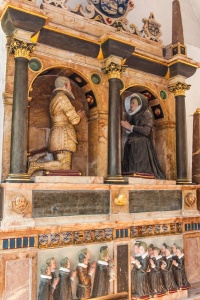
Another indication that the original church was set lower than the current building is a blocked 13th-century priest's door in the chancel. The door is set at such a low level that access today would be extremely difficult.
The chancel arch is 14th century, and the nave has several interesting 17th-century pews, including a large box pew for the Palmers of Dorney Court.
Medieval Paintings
Three medieval wall paintings survive inside the church. Two of these flank the doorway to the Garrard Chapel in the north wall of the chancel. On one side of the door is the Virgin Mary, while on the other is a figure of the Archangel Gabriel.
Together these two figures are thought to have been part of a larger Annunciation scene. They probably date to the early 14th century. The paintings were hidden beneath lime wash since the Reformation, and were only rediscovered in 1926.T he third section of medieval painting can be seen in the gallery loft, to the south of the tower arch.
The Garrard Chapel was added in the late 16th century as a mortuary chapel, probably replacing a 14th-century chapel in this location. It is accessed through a set of very nice 17th century wooden gates.
The Garrard Memorial
Within the Garrard Chapel is the historical highlight of St James' an ornate monument to Sir William Garrard (d. 1607) and his wife Elizabeth. The style is typical of the early Jacobean period, with the couple kneeling within niches, facing each other, while their numerous children - 7 boys and 8 girls - are arrayed in prayerful attitude across the base of the tomb.
Five of the children carry skulls, a symbol that they died young. So five out of the couple's 15 offspring died in childhood, a reminder of just how difficult life could be even for the wealthiest classes. Because of the deaths, some of the children's names were re-used for subsequent births. The figures are painted and gilded, and the effect is simply marvellous.
THE GARRARD MONUMENT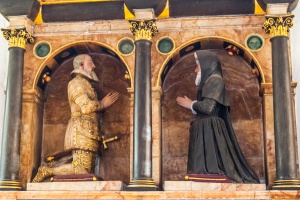
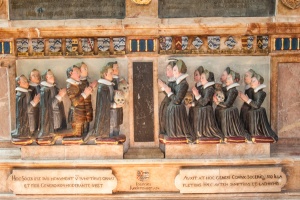
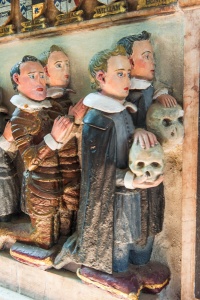
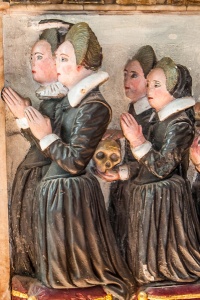
Aside from the Garrard monument, the finest memorial in the church is a gilded wall tablet to Jane Palmer (d. 1663), youngest daughter of Sir James Palmer of Dorney, who died at the age of 21. It is fascinating to read the inscription, which deals not with Jane but with her parent's official posts and family ties. Its a reminder of just how important such things were in the early 17th century; it wasn't who you were, it was who you were related to.
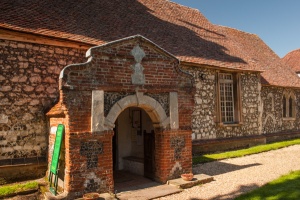
The south porch, by which you enter the church, was built in red brick and dates to 1661. It was built to commemorate the birth of Lady Alice Palmer, the child of Barbara Villiers, Countess Castlemaine, and Roger Palmer, the 1st Earl of Castlemaine and lord of Dorney. Or was the Earl Lady Anne's true father? Barbara Villers was Charles II's mistress, and Charles certainly regarded Lady Anne as his own child. The porch protects the lovely Tudor door, now restored.
Other features worth noting include the small 'dolphin window' in the north wall by the base of the gallery stairs. This was installed in 1991 after an older window was stolen. It shows a brightly coloured dolphin, starfish, fish, and shell.
The church has regular open days in summer, and is usually open when the manor is open. I highly suggest making a joint visit to see the manor house and church together!
About Dorney
Address: Court Lane,
Dorney,
Buckinghamshire,
England, SL4 6QP
Attraction Type: Historic Church
Location: Immediately behind Dorney Court manor house. Parking near the gates to the manor drive.
Website: Dorney
Location
map
OS: SU924789
Photo Credit: David Ross and Britain Express
HERITAGE
 We've 'tagged' this attraction information to help you find related historic attractions and learn more about major time periods mentioned.
We've 'tagged' this attraction information to help you find related historic attractions and learn more about major time periods mentioned.
Find other attractions tagged with:
NEARBY HISTORIC ATTRACTIONS
Heritage Rated from 1- 5 (low to exceptional) on historic interest
Dorney Court - 0.1 miles (Historic House) ![]()
Bray, St Michael's Church - 1.5 miles (Historic Church) ![]()
Taplow Court - 2.3 miles (Historic House) ![]()
Eton College - 2.6 miles (Historic Building) ![]()
Legoland - 2.8 miles (Family Attraction) ![]()
Windsor Guildhall - 2.9 miles (Historic Building) ![]()
St George's Chapel - 3 miles (Historic Church) ![]()
Windsor Castle - 3 miles (Castle) ![]()
Nearest Holiday Cottages to Dorney:
Holmer Green, Buckinghamshire
Sleeps: 8
Stay from: £2188 - 7957
More self catering near Dorney
